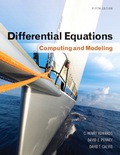
Concept explainers
In Problems 1 through 16, a homogeneous second-order linear differential equation, two functions
Program Description: Purpose of problem is to verify that
Explanation of Solution
Given information:
The homogeneous second order differential equation is
The value of
The initial condition is
Explanation:
The given differential equation can be represented as,
Substitute
Therefore, it is verified that
Substitute
Therefore, it is verified that
The solution of the differential equation can be written as,
Substitute,
Differentiate equation (3) with respect to x as shown below.
Apply first initial condition
Apply second initial condition
Substitute
Therefore, the value of
Substitute
Conclusion:
Thus, the solution of differential equation
Want to see more full solutions like this?
Chapter 3 Solutions
EBK DIFFERENTIAL EQUATIONS
Additional Math Textbook Solutions
Modern Database Management (12th Edition)
Introduction To Programming Using Visual Basic (11th Edition)
Starting Out with Python (3rd Edition)
Starting out with Visual C# (4th Edition)
Concepts Of Programming Languages
Starting Out with Java: From Control Structures through Objects (6th Edition)
- Q2/ Determine the general solution for the following differential equations using D- operator method:arrow_forwardSolve the following homogeneous recurrence equations and obtain the general solution and the solution based on the initial conditionsarrow_forwardSolve the given problems A and Barrow_forward
- find the solution of the following LP problems using simplex and graphical methodarrow_forward1. Determine the equation of the line through the given point (a) parallel and (b) perpendicular to the given line Given: Point: ( -1,-4) Line: 4x-2y=3arrow_forwardfind the general solution to the following cauchy-euler differential equation. x2y''+xy'-9y=2xInxarrow_forward
 Database System ConceptsComputer ScienceISBN:9780078022159Author:Abraham Silberschatz Professor, Henry F. Korth, S. SudarshanPublisher:McGraw-Hill Education
Database System ConceptsComputer ScienceISBN:9780078022159Author:Abraham Silberschatz Professor, Henry F. Korth, S. SudarshanPublisher:McGraw-Hill Education Starting Out with Python (4th Edition)Computer ScienceISBN:9780134444321Author:Tony GaddisPublisher:PEARSON
Starting Out with Python (4th Edition)Computer ScienceISBN:9780134444321Author:Tony GaddisPublisher:PEARSON Digital Fundamentals (11th Edition)Computer ScienceISBN:9780132737968Author:Thomas L. FloydPublisher:PEARSON
Digital Fundamentals (11th Edition)Computer ScienceISBN:9780132737968Author:Thomas L. FloydPublisher:PEARSON C How to Program (8th Edition)Computer ScienceISBN:9780133976892Author:Paul J. Deitel, Harvey DeitelPublisher:PEARSON
C How to Program (8th Edition)Computer ScienceISBN:9780133976892Author:Paul J. Deitel, Harvey DeitelPublisher:PEARSON Database Systems: Design, Implementation, & Manag...Computer ScienceISBN:9781337627900Author:Carlos Coronel, Steven MorrisPublisher:Cengage Learning
Database Systems: Design, Implementation, & Manag...Computer ScienceISBN:9781337627900Author:Carlos Coronel, Steven MorrisPublisher:Cengage Learning Programmable Logic ControllersComputer ScienceISBN:9780073373843Author:Frank D. PetruzellaPublisher:McGraw-Hill Education
Programmable Logic ControllersComputer ScienceISBN:9780073373843Author:Frank D. PetruzellaPublisher:McGraw-Hill Education





